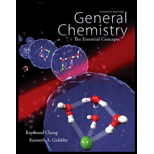
Interpretation:
To Calculate and analyze the each partial pressure
Concept Introduction:
Equilibrium constant: Concentration of the products to the respective molar concentration of reactants it is called equilibrium constant. If the K value is less than one the reaction will move to the left side and the K values is higher (or) greater than one the reaction will move to the right side of reaction.
Equilibrium pressure: The equilibrium constant calculated from the partial pressures of a reaction equation. It is used to express the relationship between product pressures and reactant pressures. It is unites number, although it relates the pressures.
Temperature affect in equilibrium: This process chemical shifts changes (or) towards the product or reactant, which can be determined by studying the reaction and deciding whether it is exothermic or endothermic.
Kp and Kc: This equilibrium constants of gaseous mixtures, these difference between the two constants is that Kc is defined by molar concentrations, whereas Kp is defined by the partial pressures of the gasses inside a closed system.
Answer to Problem 15.95QP
The reactant and product equilibrium (Kp) pressure values are given the statement of (NO2) homogenous reaction is shown below.
Explanation of Solution
To find: Calculate the each partial pressure
Calculate and analyze the
First we derived the equilibrium pressure values of given statement
Here volume is double so pressure is halved, further the calculate the reaction quintet (Qp) and compare it to Kp.
So the equilibrium will shifted to the right, some
Hence we derive here equilibrium pressure values of reactant and product.
Finally we solved the both equilibrium as fallowed as
The given
The each reactant and product values are calculated given the nitrogen dioxide formation reaction and corresponding temperature at
Want to see more full solutions like this?
Chapter 15 Solutions
Package: General Chemistry with Connect 2-year Access Card
 ChemistryChemistryISBN:9781305957404Author:Steven S. Zumdahl, Susan A. Zumdahl, Donald J. DeCostePublisher:Cengage Learning
ChemistryChemistryISBN:9781305957404Author:Steven S. Zumdahl, Susan A. Zumdahl, Donald J. DeCostePublisher:Cengage Learning ChemistryChemistryISBN:9781259911156Author:Raymond Chang Dr., Jason Overby ProfessorPublisher:McGraw-Hill Education
ChemistryChemistryISBN:9781259911156Author:Raymond Chang Dr., Jason Overby ProfessorPublisher:McGraw-Hill Education Principles of Instrumental AnalysisChemistryISBN:9781305577213Author:Douglas A. Skoog, F. James Holler, Stanley R. CrouchPublisher:Cengage Learning
Principles of Instrumental AnalysisChemistryISBN:9781305577213Author:Douglas A. Skoog, F. James Holler, Stanley R. CrouchPublisher:Cengage Learning Organic ChemistryChemistryISBN:9780078021558Author:Janice Gorzynski Smith Dr.Publisher:McGraw-Hill Education
Organic ChemistryChemistryISBN:9780078021558Author:Janice Gorzynski Smith Dr.Publisher:McGraw-Hill Education Chemistry: Principles and ReactionsChemistryISBN:9781305079373Author:William L. Masterton, Cecile N. HurleyPublisher:Cengage Learning
Chemistry: Principles and ReactionsChemistryISBN:9781305079373Author:William L. Masterton, Cecile N. HurleyPublisher:Cengage Learning Elementary Principles of Chemical Processes, Bind...ChemistryISBN:9781118431221Author:Richard M. Felder, Ronald W. Rousseau, Lisa G. BullardPublisher:WILEY
Elementary Principles of Chemical Processes, Bind...ChemistryISBN:9781118431221Author:Richard M. Felder, Ronald W. Rousseau, Lisa G. BullardPublisher:WILEY





